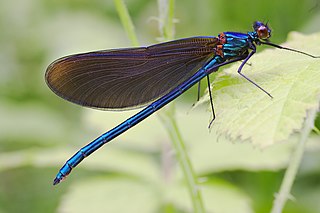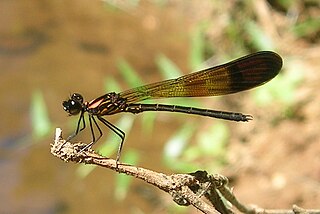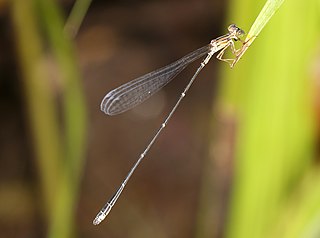
Damselflies are flying insects of the suborder Zygoptera in the order Odonata. They are similar to dragonflies but are usually smaller and have slimmer bodies. Most species fold the wings along the body when at rest, unlike dragonflies which hold the wings flat and away from the body. Damselflies have existed since the Late Jurassic, and are found on every continent except Antarctica.

Coenagrionidae or are a family of damselflies, also known as pond damselfies, in the order Odonata and the suborder Zygoptera. The Zygoptera are the damselflies, which although less known than the dragonflies, are no less common. More than 1,300 species are in this family, making it the largest damselfly family. The family Coenagrionidae has six subfamilies: Agriocnemidinae, Argiinae, Coenagrioninae, Ischnurinae, Leptobasinae, and Pseudagrioninae.

Calopterygidae is a family of damselflies, in the suborder Zygoptera. They are commonly known as the broad-winged damselflies, demoiselles, or jewelwings. These rather large damselflies have wingspans of 50–80 mm, are often metallic-coloured, and can be differentiated from other damselflies by the broader connection between the wings and the body, as opposed to the abrupt narrowing seen in other damselfly families. The family contains some 150 species.

The Lestidae are a rather small family of cosmopolitan, large-sized, slender damselflies, known commonly as the spreadwings or spread-winged damselflies.

The Platycnemididae are a family of damselflies. They are known commonly as white-legged damselflies. There are over 400 species native to the Old World. The family is divided into several subfamilies.
Chalcothore is a genus of damselfly in family Polythoridae. It contains the following species:
Cora aurea is a species of damselfly in the family Polythoridae known commonly as the black-banded bannerwing. It is endemic to Colombia, where it has been noted at only three locations.
Stenocora is a monotypic genus of damselflies in the family Polythoridae, the bannerwings. It contains the single species Stenocora percornuta, which is known commonly as the horned bannerwing. It is native to Ecuador and Peru. Little is known about the species.

Chlorocyphidae is a family of damselflies, commonly known as jewels. These are colorful species native to the Old World tropics, where they occur along forest streams. They are most diverse in Southeast Asia.

Platystictidae is a family of damselflies, commonly known as shadowdamsels. They look very similar to the threadtail damselfly family (Protoneuridae). They can mostly be found throughout Asia, Central America, and South America.

Isostictidae is a family of small to medium-sized damselflies restricted to Australia, New Caledonia, and New Guinea. It contains 12 genera and more than 40 species. Members of this family resemble species in the threadtail family (Protoneuridae).

Coenagrionoidea is a superfamily of closed wing damselflies of the order Odonata found worldwide.

Chalcolestes viridis, formerly Lestes viridis, is a damselfly of the family Lestidae. It has a metallic green body and at rest it holds its wings away from its body. Its common name is the willow emerald damselfly, the green emerald damselfly, or the western willow spreadwing. It has an elongated abdomen and pale brown spots on its wings and resides in areas of still water with overhanging trees.

Diphlebiidae is no longer recognised as a biological family. It was the name given to a small family of damselflies, the azure damselflies, with species in two genera: Diphlebia and Philoganga. Diphlebia is found in Australia and Philoganga is found in Southeast Asia. They are large and thick-bodied damselflies. They rest with their wings spread out. The Diphlebiidae were also known as Philogangidae.

The Perilestidae are a family of damselflies commonly known as shortwings and twigtails. It is a small family of around 19 species. All extant species are native to the Neotropical realm. In the past Nubiolestes of Africa was included in this family, but this is doubted. Palaeoperilestes electronicus is an extinct species described from mid-Cretaceous Burmese amber.
Cora is a genus of damselflies in the family Polythoridae, the bannerwings. In a 1990 revision there were 18 species.

Calopterygoidea is a superfamily of damselflies in the order Odonata.
Miocora is a genus of damselflies in the family Polythoridae. There are at least two described species in Miocora.

Polythore is a genus of damselflies in the family Polythoridae. There are about 19 described species in Polythore.













